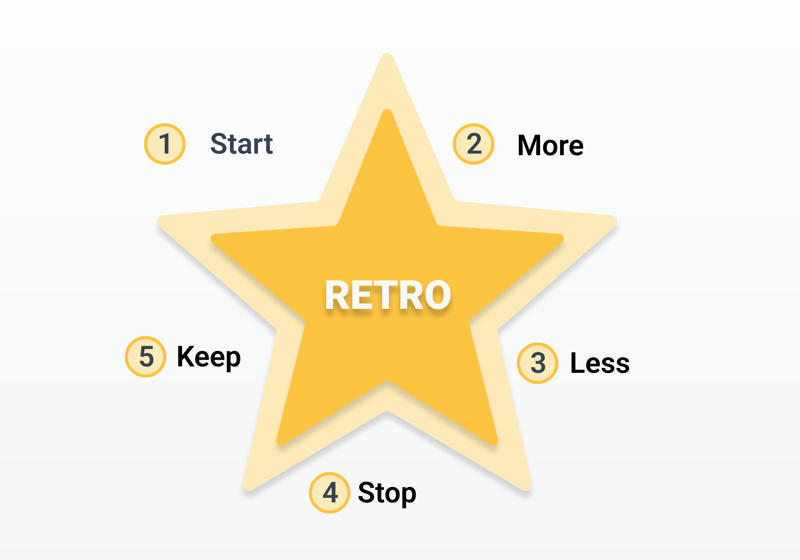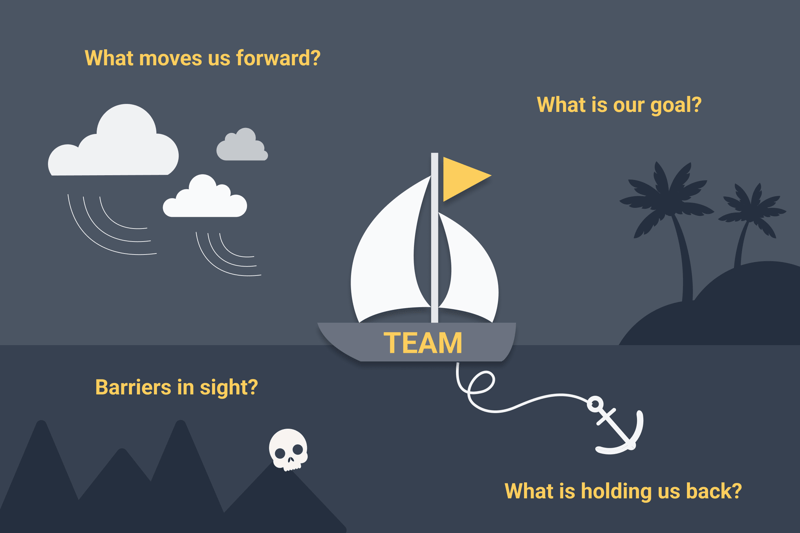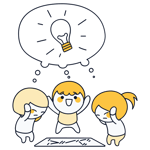Every project needs structure and deadlines to have a shot at success. In the agile project management method, retrospectives refine and make both more efficient through constantly enhancing and improving teamwork.
But what is a retrospective and how can effectively organize and perform one? Below, we'll tell you everything you need to know to get the most out of this important meeting and bring your company's teamwork to the next level, even for non-agile projects.
Fundamentals of a Retrospective
A retrospective, or 'retro', is a recurring event in the Scrum agile project management framework. It's defined as:
A retrospective is a meeting during which teams reflect on and evaluate the most recently completed sprint.
Origins
Even though retrospectives are a key element of Scrum, they're frequently used outside of it as well. This is because retrospectives are equally well-suited to the discussion of both successes and failures and can help to identify future areas for improvement.
This reflective approach is as old as time and can be traced back as far as the Ancient Greeks, and Socrates. In the dialogues he conducted with his students about 2,500 years ago, he reflected upon and challenged their thought patterns and reasoning.
The modern business world has rediscovered the value of this approach. Scrum has sharpened and streamlined how organizations reflect through the addition of rules, guidelines, and frameworks.
Retrospective Goals
The main goals of a retrospective are to uncover problems, learn from mistakes, and find solutions. Based on the team and project phase, objectives might include:
Improvement of communications
Process optimization
Encouragement of team spirit and teamwork
Early identification of challenges
Increased efficiency and productivity
Joint learning and growth
Strengthened self-reflection and individual responsibility
Promotion of creativity and innovation
Principles and Rules
For a retrospective to have the intended effect, an environment of trust is needed in which everyone feels free to voice their opinions. To create this, there are two, easy to remember ground rules that you'll need to establish among participants:
The Vegas rule: What happens at a team meeting stays in a team meeting! Team members need to trust one another and be confident that what they've said won't be repeated elsewhere. This boosts trust within teams and removes communication barriers.
The golden rule: To get respect, you have to give it. Encourage constructive feedback and solutions: finger-pointing and accusations have no place here.
How Does a Retrospective Proceed?
According to Esther Derby and Diane Larsen, retrospectives can only promote effective teamwork if done in a structured way. And they should know, since their book, "Agile Retrospectives: Making Good Teams Great" is seen as the go-to guide for retrospectives.
Based on the two renowned authors' experience as agile software development experts, they've identified five phases that every team should go through during a retrospective:
Phase | Description |
|---|---|
Phase 1: Setting the Stage | This is about the creation of a positive atmosphere in which all team members feel able to freely voice their opinions and ideas. |
Phase 2: Gathering Data | Information and data from the most recently finished sprint or last project segment is collected. This helps to identify problems and difficulties. |
Phase 3: Generating Insights | Now it's time to analyze the data that was collected in the previous phase. This helps to notice patterns, connections, and the actual reasons for problems. |
Phase 4: Deciding What to Do | In this phase, the team picks the most important problems and challenges and decides how to resolve or overcome them. Formulate goals in a SMART way to give them the best shot at success. For more information, you can check out the SMART formula. |
Phase 5: Closing | In this final phase, the team concludes the retrospective and reflects upon the process in and of itself. This is when areas of improvement for future retrospectives can be discussed. |
Who Participates in a Retrospective?
Since retrospectives are personal and focused on collaboration and teamwork, only the Scrum Team should participate. This means the developer, the Scrum Master, and the Product Owner. Other team members or guests shouldn't be present as they can impair the atmosphere of trust and openness essential to a retrospective's success.
Other departments often ask whether they could sit in on a retrospective to see the method in action and help integrate it into their own teams. This is possible, however, the Scrum Team should do so only during a non-critical phase.
Length and Frequency
In Scrum, how often a retrospective is held depends on the iteration cycle. A retrospective takes place at the end of every sprint. Teams that don't work in sprints need to select an optimal interval for their retrospective. To drive change and improvement, every four or six weeks is a good place to start.
The length of a retrospective depends on the team's size since everyone should get a chance to speak. 60-90 minutes will be adequate for the majority of teams.
Why Are Retrospectives Important?
You probably know of at least one project that hasn't gone anywhere or missed its goals by a wide margin. Most of the time, this can be traced to a lack of direction, poor communication, undeveloped processes, and/or an inability to detect errors or mistakes.
A retrospective allows teams to regularly check the effectiveness of their efforts. What went well and what might be improved? Constructive criticism and feedback help teams to continually grow and improve. Looking back can help to illuminate the path forward and take an easier or better route toward project or organizational goals.
Advantages and Disadvantages of Retrospectives
Like all processes and meetings, retrospectives have advantages and disadvantages.
Evaluate achievements and identify areas for improvement
Facilitate open communication and feedback
Help identify problems that impact a team's success
Promote a culture of continuous improvement
Highlight personnel, capability, and resource gaps
Strengthen relations between team members and boost team spirit
Greater engagement, self-organization, and responsibility
Drive process optimization
Provide a space for conflict solutions and bettering the work climate
Can enhance team performance
Consume time and resources in the implementation phase
Poorly defined goals and a lack of focus cause discussions that waste valuable time
Team members prefer not to openly discuss problems, which prevents their resolution
Require a disciplined moderator to not become counter-productive
Only effective when teams regularly conduct them
Some teams concentrate too heavily on problems without celebrating successes
Preparations for an Effective Retrospective
Would you like your next Scrum meeting to be a complete success? If so, there are a few easy steps that you can take. When you're well-prepared, you'll be able to benefit from the advantages of an effective retrospective and avoid all of its downsides.
Set the Stage
To get the most out of your retrospective, make sure that your goals are clearly defined. Each requires a specific methodology that is relevant and appropriate to the task at hand.
Also, keep in mind that every methodology has different requirements. Do you need any special tools or visual aids? It might sound silly, but making the right preparations plays a major role in any meeting's success. Come prepared and have everything you need.
The Moderator's Role
Downplay the role of the moderator at your own peril! They ensure a safe and open environment where any opinion can be voiced. Moderators also keep discussions on track and actively involve all participants.
What makes a good moderator? Here are a few characteristics:
Effective communicator: A moderator should be able to clearly communicate the purpose, goals, and intended results of a retrospective.
Active listener: This includes posing questions and encouraging participants to contribute and voice their opinions.
Flexible: Skilled moderators are able to adapt their approach to the topic at hand.
Methodological competence: It's important for moderators to have a well-developed knowledge of different methods, to make decisions, and to guide the meeting.
Objective: A good moderator remains neutral in the eyes of all participants and does not judge their contributions.
Conflict resolution skills: Whenever differences or conflicts arise, the moderator must handle and help resolve them.
Does your team use Scrum? If so, the moderator is the same person who prepares the retrospective: the Scrum Master. For non-agile projects, it's pick a moderator who has all of the above skills and is able to effectively lead the meeting.
Create an Atmosphere of Openness
Each member of the team should feel that they can freely voice their thoughts and opinions, without being judged by their peers. To encourage this, make sure that you begin every retrospective with an overview of the Vegas rule and the golden rule. This helps to structure the meeting and determine its course with a set of guidelines.
To get everyone on board, you might want to consider a creative check-in exercise or icebreaker. This should vary from meeting to meeting.
Here are a few suggestions:
What are you proud of today?
Tell us three positive things about yourself.
Describe a situation when you had to find a creative solution to a challenge.
What advice would you give the 18-year-old you?
What's the title of a book that you're currently reading?
5 Retrospective Methods and Techniques
Methods and techniques give structure to any retrospective. Make sure that you set a suitable goal for every meeting and select a slightly different technique to encourage creativity. We briefly summarized five popular methods below, and explain scenarios in which they might be used.
Often, there's a physical or digital visualization, and team members are given time to prepare cards that are grouped under certain columns or themes. Everyone needs to offer and present at least one of these, as well as an answer to each.
Starfish Retrospective
This is a classic retrospective technique and is mostly used when teams need to reach a joint decision. The method's name comes from its five aspects, the shape of which evokes a starfish.

Among retrospectives, the Starfish method is a classic.
Three Little Pigs
This creative and playful technique helps to design team meetings. Do you remember the fairytale about the three little pigs and the wolf? With this approach, you'll use it to investigate methodical and technical processes.
Teams should pose the following questions:
What are our fragile straw houses?
What are our stick houses (stable, but not error-free)?
What are our unbreakable brick houses?
Which hungry wolves (obstacles) appeared, demolished our straw houses, and shook our stick ones?
Because of its elements, this method is also known as straw, sticks, and bricks.
Sailboat Retrospective
A sailboat retrospective helps teams reflect upon their last project's phases. They'll be able to identify what went well and where there's room for improvement. This makes it perfect for gathering new insights. The visual metaphor represents the project team as a ship, sailing towards a particular destination.

The sailboat technique is creative and can be adapted to your team's needs.
The team identifies what brought them closer to their goals (wind), as well as what held them back (anchor). A goal is visualized as an island, while potential dangers are depicted as rocks along the shore or a reef. The visualization can be easily adjusted or expanded. You can add the sun, symbolizing success or a bright spot in the project, or a treasure chest to help identify the team or project value.
Mad, Sad, Glad
This technique is a bit simpler than the others and all about individual team members and their emotions. They express what upset them, made them sad, as well as what made them happy. Simply draw and label three columns, and the visual aid is ready.
Those who use this method get a unique chance to better understand other members of the team and their emotions. Everyone can express their feelings and give constructive feedback. This helps not only to optimize and further develop the next sprint but also to grow as a team.
4 Ls Method
How about another classic? The "4 Ls" method. These stand for:
Loved: What did the team like or find positive?
Learned: What did the team learn?
Lacked: What was missing from the sprint or project?
Longed for: What would the team have liked to see?
This approach is particularly good if you want to constructively address the sprint or a particular project aspect. Here too, all that's needed is a simple visual aid (four columns or quadrants).
There are some variants to the 4 Ls method: it's possible to substitute "loathed" for "lacked". This changes the focus to aspects that made the team's life harder or were not liked.
Usage Tips
A retrospective should be a valuable and rewarding team experience since it's all about jointly reflecting upon what's happened and growth. With that said, there are some tips to get the most out of the meeting, and we've summarized them below.
Document and Measure Progress
If you document results and stick to goals set for the next iteration, you'll have a promising opportunity to measure progress.
One easy way to do this is to write down results on a whiteboard or flipchart. This can also be done digitally, with programs like Jira, and helps team members to track progress.
Continually Update and Develop the Retrospective
Retrospectives are a powerful tool, but must be used properly. In practice, this means: It's never too late to experiment or improve. You can offer your teams a dynamic and fresh retrospective experience through the continuous development and trial of new strategies and techniques.
Use Aids and Tools
Just because experimentation and change are important doesn't mean that you need to reinvent the wheel every few weeks. There are plenty of resources and tools that help to prepare for and execute retrospectives. Here are a few examples:
Miro: This offers a range of different retrospective templates and visualizations.
Retromat: Are you looking for check-in ideas, different techniques, or tips on how to wrap up a retrospective? You'll find plenty of different templates and suggestions here.
Retrium: This retrospective tool serves up a variety of different features that simplify all stages of the process, from preparation to gathering feedback.
Easyretro: Use this to quickly create and manage a retrospective.
There are plenty of other resources that can support your team in their efforts. Approaches, features, and techniques differ, with both free and premium options available. Try out a variety and see what works best for you and your team.
How to Handle Challenges and Obstacles
There are several common obstacles that can obstruct or disrupt a retrospective. Some of the most common problems include a lack of time, participant interaction, or constructiveness.
To avoid these, moderators should create a positive atmosphere in which discussions can thrive. They must actively solicit feedback and ensure that it's constructive and non-judgemental. Finally, they need to remain flexible, use a timebox, and not lose sight of the team dynamic.
Checklist
We prepared a brief checklist to use and see whether your retrospective fulfills all important aspects or if there are any areas for improvement.
Set and communicate clearly defined goals for the retrospective
Select an appropriate/relevant approach
Prepare any necessary materials or resources
Ensure that all team members can participate
Encourage a positive and open atmosphere
Set and discuss ground rules for respectful communication
Gather experiences, observations, and ideas from team members
Jointly analyze the gathered data and information
Identify important insights and trends
Derive concrete improvement measures
Set and prioritize measures and determine who is responsible for their execution
Develop realistic action plans that correspond to the team's goals and resources
Document results and agreed-upon measures
Check progress of implemented measures in the following retrospective
Use feedback and experiences to improve future retrospectives
Conclusion
Retrospectives offer teams a valuable tool to improve their performance. Even though it's heavily linked to Scrum, retrospectives are used by all kinds of project teams, even those that aren't agile.
When you set clear goals, choose the right methods, and create a positive atmosphere, you'll be able to gather important insights and identify trends. Work through each of the five phases above and try out the various methods and tools we've mentioned to see which works best for you and your team. Just remember: Consistency is key, and retrospectives only work when you regularly hold them.











